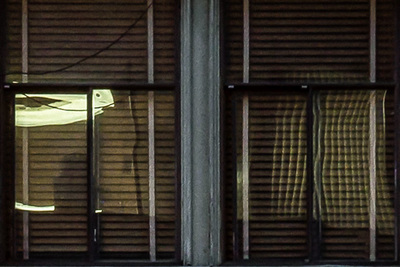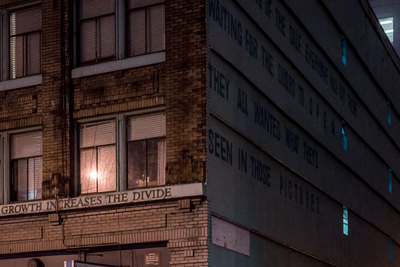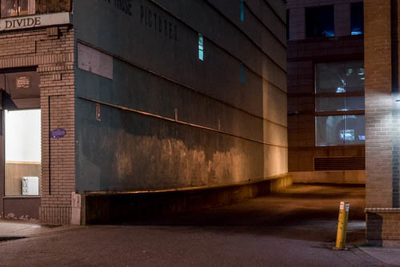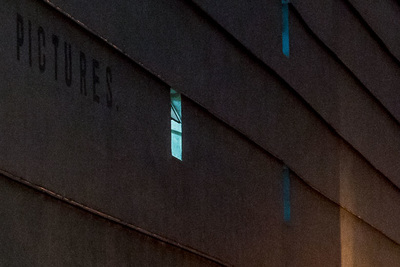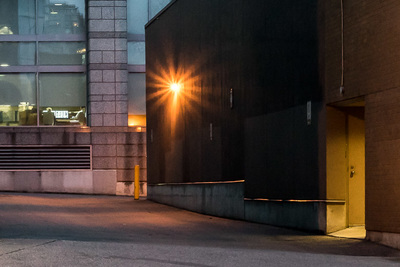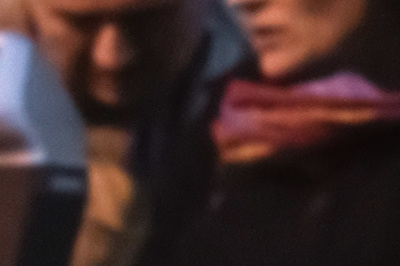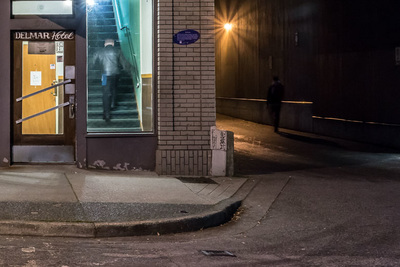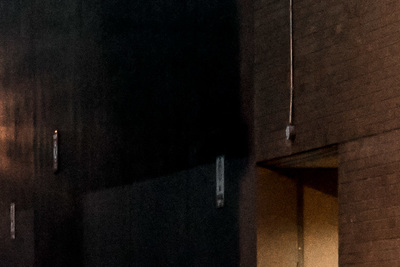unlimited growth inc:
writings on the wall, spaces within, spaces whatever
gallery and text below:
Unlimited Growth Inc:
writings on the wall, spaces within, spaces whatever
There are times when, literally, the writing is on the wall. The catch is finding, or noticing, the wall and its inscription. I have come across a hotel façade several times walking around downtown Vancouver. It is an old hotel or rooming house, deserving of heritage label, nearly derelict but graceful in its proud stance and, more importantly, expounding on the power of the word. It has a weathered statement in a horizontal strip above the doorway that expands the narrow width of the building; the inscribed message, like the engraving on a tombstone, stands as an intrinsic part of the structure, it is its decorative frieze:
UNLIMITED GROWTH INCREASES THE DIVIDE
Other sentences, maybe verses, run in large letters along the green north side wall alluding to notions of blind consumerism and, indirectly, to the enticing power of images:
THE MORNING OF THE SALE, EVERYONE WAS OUT THERE
WAITING FOR THE DOORS TO OPEN.
THEY ALL WANTED WHAT THEY’D
SEEN IN THOSE PICTURES.
“Unlimited growth increases the divide.” A simple yet profound statement on the ravaging results of capitalism unleashed.
I have returned to this location to admire its at times mundane and at times evocative photogenic quality, and I have photographed the message and the stoic old building standing alone in the midst, in the heart, of an evolving modern city, its dark weathered brick and slanting cream colored venetian blinds defining its contrasting urban presence.
Later I have probed the resulting images over time and circumstance. The photographs, fragments of a city in the transition from dusk to night, have been further fragmented, refragmented, in the process of uncovering and extracting spaces within. Spaces within, images within images, provided by the analytical process of observation and selection -cropping and editing-, have always interested me as manifestations of, or extractions from, a world characterized by the fragmented limitations of our visual scope. They are physical as well as conveyors of a withinness of the spirit.
I consider these spaces-within to be related to the notions of “any-space-whatevers” or “any-spaces-whatever” elaborated on by the philosopher Gilles Deleuze in his reflections on the cinematic image. Without pretending to elucidate Deleuze’s meandering abstractions on the subject, my reductive take in this context is that any-space-whatevers are constituent scenic features of an expressive visual language that demonstrate an intention to use elements of form as agents that empower an image, or a visual narrative, with affect. Deleuze identifies three types or modes of any-space-whatevers in film language: those created by the potentiality of darkness (expressionism), those produced by the potentiality of light (impressionism), and those generated by the absorbency of color (colorism). He further identifies two conditions or states that characterize any-space-whatevers: “deconnection” and “emptiness”. He specifically defines those spaces-whatever sourced by light as “lyrical abstractions”, a term I find particularly helpful in understanding his often complex conceptual trajectory because it clearly identifies these spaces as being potentialized by, or invested with, affective qualities that elevate them from the realm of the concrete, the tangible and the determinate, to the realm of the indeterminate, the expressive (or, in his terms, “the spiritual”). At the expense of simplification I prefer to view all of these manifestations of any-space-whatevers as variant modes of “lyrical abstraction”. They are expressive constructs; structural components of a visual language.
If one were to consider the language of photography in linguistic terms, in terms of the operational patterns of spoken or written language, then, any-space-whatevers would have the qualitative value associated with adjectives rather than the nominative value associated with nouns. Any-space-whatevers are expressive, rather than explicative or determinative. They do not primarily intend to identify or name, they aim to convey or intimate. It is in this sense that Deleuze endows them with a transcendent value; for their inherent qualities do not stay within the confines of a description or presentation of a physical space but, rather, they cross over to an expressive space of affect.
The things or spaces photographed, or imaged, and conceptualized in this context are not presented, for example, as buildings, windows, or trees in a landscape; they are not construed as determinate objects or scenes, or as depictions of specific acts with corresponding actors or agents. The images relate to qualities; they are qualities rather than things; they are qualities-of rather than things-in, they are characteristic features, nuances. They are like adjectives possibly in conjunction with, often without, corresponding nouns. They are scenic, suggestive, expressive, allusive rather than explicative. They are not necessarily shadows or darkness, they are dark -dark in a combined denotative and connotative sense; they are not lamps or street lights, but light; not blood, but red (Goddard); not a canary, but yellow; not the song of a canary, but “yellow chirping” (Lorca); not rain, but the aggregate or conjunctive feeling of rain, “rain as affect” (Deleuze); not a specified space but an indeterminate space, a space-whatever, an any-space-whatever.
The series of images presented here constitutes a photographic essay that attempts to expand the expressive boundaries of the single image by directing the attention to particular areas and properties. Beyond documenting a suggestive urban setting that displays contrasting civic structures and expressly comments on our global consumer culture, the images explore qualities of subjacent spaces-within as they present displacements of a topographic nature towards distinctive inner spaces and back to the larger settings that enclose them. They are segments, fragments of a larger whole, and they are graphic instances of the allusive potentialities of light, darkness, color, disconnection and emptiness characteristic of any-space-whatevers. They are contemplative spaces, expressive constructs made possible by the liberty to delve into lyrical abstraction.
Unlimited Growth Inc:
writings on the wall, spaces within, spaces whatever
There are times when, literally, the writing is on the wall. The catch is finding, or noticing, the wall and its inscription. I have come across a hotel façade several times walking around downtown Vancouver. It is an old hotel or rooming house, deserving of heritage label, nearly derelict but graceful in its proud stance and, more importantly, expounding on the power of the word. It has a weathered statement in a horizontal strip above the doorway that expands the narrow width of the building; the inscribed message, like the engraving on a tombstone, stands as an intrinsic part of the structure, it is its decorative frieze:
UNLIMITED GROWTH INCREASES THE DIVIDE
Other sentences, maybe verses, run in large letters along the green north side wall alluding to notions of blind consumerism and, indirectly, to the enticing power of images:
THE MORNING OF THE SALE, EVERYONE WAS OUT THERE
WAITING FOR THE DOORS TO OPEN.
THEY ALL WANTED WHAT THEY’D
SEEN IN THOSE PICTURES.
“Unlimited growth increases the divide.” A simple yet profound statement on the ravaging results of capitalism unleashed.
I have returned to this location to admire its at times mundane and at times evocative photogenic quality, and I have photographed the message and the stoic old building standing alone in the midst, in the heart, of an evolving modern city, its dark weathered brick and slanting cream colored venetian blinds defining its contrasting urban presence.
Later I have probed the resulting images over time and circumstance. The photographs, fragments of a city in the transition from dusk to night, have been further fragmented, refragmented, in the process of uncovering and extracting spaces within. Spaces within, images within images, provided by the analytical process of observation and selection -cropping and editing-, have always interested me as manifestations of, or extractions from, a world characterized by the fragmented limitations of our visual scope. They are physical as well as conveyors of a withinness of the spirit.
I consider these spaces-within to be related to the notions of “any-space-whatevers” or “any-spaces-whatever” elaborated on by the philosopher Gilles Deleuze in his reflections on the cinematic image. Without pretending to elucidate Deleuze’s meandering abstractions on the subject, my reductive take in this context is that any-space-whatevers are constituent scenic features of an expressive visual language that demonstrate an intention to use elements of form as agents that empower an image, or a visual narrative, with affect. Deleuze identifies three types or modes of any-space-whatevers in film language: those created by the potentiality of darkness (expressionism), those produced by the potentiality of light (impressionism), and those generated by the absorbency of color (colorism). He further identifies two conditions or states that characterize any-space-whatevers: “deconnection” and “emptiness”. He specifically defines those spaces-whatever sourced by light as “lyrical abstractions”, a term I find particularly helpful in understanding his often complex conceptual trajectory because it clearly identifies these spaces as being potentialized by, or invested with, affective qualities that elevate them from the realm of the concrete, the tangible and the determinate, to the realm of the indeterminate, the expressive (or, in his terms, “the spiritual”). At the expense of simplification I prefer to view all of these manifestations of any-space-whatevers as variant modes of “lyrical abstraction”. They are expressive constructs; structural components of a visual language.
If one were to consider the language of photography in linguistic terms, in terms of the operational patterns of spoken or written language, then, any-space-whatevers would have the qualitative value associated with adjectives rather than the nominative value associated with nouns. Any-space-whatevers are expressive, rather than explicative or determinative. They do not primarily intend to identify or name, they aim to convey or intimate. It is in this sense that Deleuze endows them with a transcendent value; for their inherent qualities do not stay within the confines of a description or presentation of a physical space but, rather, they cross over to an expressive space of affect.
The things or spaces photographed, or imaged, and conceptualized in this context are not presented, for example, as buildings, windows, or trees in a landscape; they are not construed as determinate objects or scenes, or as depictions of specific acts with corresponding actors or agents. The images relate to qualities; they are qualities rather than things; they are qualities-of rather than things-in, they are characteristic features, nuances. They are like adjectives possibly in conjunction with, often without, corresponding nouns. They are scenic, suggestive, expressive, allusive rather than explicative. They are not necessarily shadows or darkness, they are dark -dark in a combined denotative and connotative sense; they are not lamps or street lights, but light; not blood, but red (Goddard); not a canary, but yellow; not the song of a canary, but “yellow chirping” (Lorca); not rain, but the aggregate or conjunctive feeling of rain, “rain as affect” (Deleuze); not a specified space but an indeterminate space, a space-whatever, an any-space-whatever.
The series of images presented here constitutes a photographic essay that attempts to expand the expressive boundaries of the single image by directing the attention to particular areas and properties. Beyond documenting a suggestive urban setting that displays contrasting civic structures and expressly comments on our global consumer culture, the images explore qualities of subjacent spaces-within as they present displacements of a topographic nature towards distinctive inner spaces and back to the larger settings that enclose them. They are segments, fragments of a larger whole, and they are graphic instances of the allusive potentialities of light, darkness, color, disconnection and emptiness characteristic of any-space-whatevers. They are contemplative spaces, expressive constructs made possible by the liberty to delve into lyrical abstraction.
all images copyright © enrique manchon 2013






